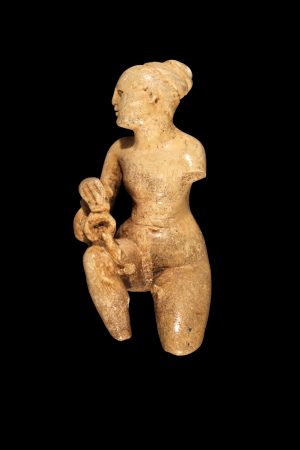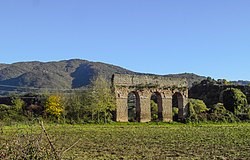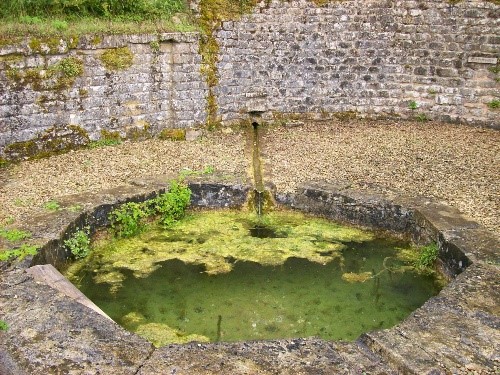Guest blog post by Rebecca Preedy
Rebecca is a finalist studying Ancient History and Classical Archaeology with Study in Europe at the University of Warwick. She came to the Corinium twice for work experience when she was at school, and has retained a love for the museum (and everything Roman) ever since. Last year Rebecca studied in Rome itself, and is hoping to continue exploring her fascination with Roman material culture at postgraduate level.

This small bone figurine housed in the museum dates to the Romano-British period. It depicts a naked woman, her head turned to look to her right-hand side and a vase of water tipped to flow elegantly over her raised knee. This isn’t an accidental spillage, however. The woman is a water nymph. But what exactly is a water nymph, and why were they so important to the Romans?
In mythology, water nymphs were divided into three categories: Oceanids of the ocean; Nereids of fresh and sea water; Naiads of flowing water. The nymph we see here probably falls into the last category, with the vase on her knee representing the water that was sacred to her. Naiads were responsible for sources of water such as rivers, wells and springs. Although only considered minor figures in the Greek and Roman mythologies, the naiads had a very important function in the belief system surrounding the natural world.

Remains of the Aqua Marcia, Rome (Wikimedia Commons)
Unlike in our society, clean water is something that the Romans could not take for granted. Provision of water was something to be praised. In the emperor Augustus’ list of achievements, for example, he notes his restoration of aqueduct channels and doubling the capacity of the Aqua Marcia. The Roman aqueducts were among greatest feats of ancient engineering. They required whole slave gangs to maintain them, and they transported water to the many bath houses of the city. There is some evidence that Corinium had its own aqueduct, although a bath house has yet to be found. This water channel would have been a source of pride and, more importantly, a source of life to the locals.
A nymph that had authority over such a vital aspect of nature was naturally seen as an important part of the Roman ecosystem. Like any other member of the mythological world, it was therefore necessary to placate nymphs in order to ensure that they would continue to favour the town with their gift. After all, the aqueducts brought in the water, but it was the nymphs who kept the springs running! The Romans would often honour the nymphs with structures called nymphaea, a sort of shrine consecrated in their name. These shrines, when found in the metropolis of Rome, were often huge statements of cascading water which were designed to show off the wealth of the owner perhaps more than they were intended to honour the nymphs. However, in the smaller communities of the empire, the shrines remained sacred places. For example, the nymphaeum at Chedworth Roman Villa was built around an existing spring that may have been the reason the villa was originally placed there.

Remains of the nymphaeum at Chedworth Roman Villa (Wikimedia Commons)
The nymph figurine from the Corinium Museum was possibly a votive gift designed to be dedicated at one of these shrines, or perhaps in a smaller one in a Roman garden like the one at the museum. The figurine, although small, is a beautiful example of worked bone. Tiny details such as the fold of her stomach, her intricate hairstyle, and the water escaping the vase have been crafted with care and skill. She looks almost ready to turn her head towards us! It is therefore no surprise that she became the inspiration for ‘Dunt: a poem for a dried-up river’ by Alice Oswold. The river may be dried-up now, but back when this nymph was dedicated, her spring would have been a source (literally!) of pride for the people of Roman Corinium.
Select Bibliography:
Claridge, A. (2010) Rome: An Oxford Archaeological Guide (Oxford: Oxford University Press)
Cleary, S. (2013) Chedworth Life in a Roman Villa (Cheltenham: History Press)
Cooley, M.G.L. (2003) The Age of Augustus (London: London Association of Classical Teachers)
Hansen, R. and Hansen, W.F. (2004) Handbook of Classical Mythology (California: ABC-CLIO)
Oswold, A. (2016) Falling Awake (London: Jonathan Cape)
Wacher, J. (2020) Towns of Roman Britain (Oxfordshire: Taylor and Francis)










